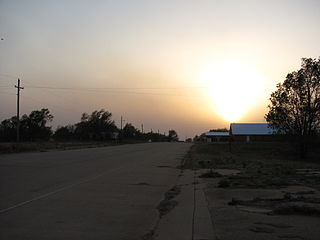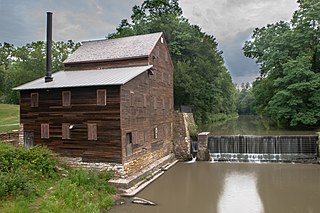
Texola is a town in Beckham County, Oklahoma, United States. The population was 36 at the 2010 census.

Bale Grist Mill State Historic Park is a California state park located in Napa County between St. Helena and Calistoga. The park is the site of a water-powered grist mill that was built in 1846 is one of only two water-driven mills remaining west of the Mississippi River.

The Graue Mill is a water-powered grist mill that was originally erected in 1852. Now a museum, it is one of two operating water-powered gristmills in Illinois. It is located on Salt Creek in Oak Brook, Illinois, owned by the Forest Preserve District of DuPage County and operated by a nonprofit preservationist group.

The Stony Brook Grist Mill is a Registered Historic Place property in Stony Brook, Suffolk County, New York. Its construction in 1699 created the Mill Pond astride the Brookhaven-Smithtown boundary. The mill structure itself dates back to at least circa 1751.

Florence Mill, also known as the Weber Mill, is a historic mill located at 9102 North 30th Street near the 30th Street exit on I-680 in the Florence community in North Omaha, Nebraska. It was built in 1846 and operated into the 1960s. It was listed on the National Register of Historic Places as Weber Mill in 1998. The mill is also known as the Mormon Mill, Grist Mill, and Old Pink Mill. It is now operated as the Winter Quarters Mill Museum and ArtLoft Gallery.

Kymulga Mill & Covered Bridge are two locally owned historic landmarks located at Kymulga Park in Talladega County, Alabama, United States. The park is on Grist Mill Road off State Route 76 about 4 miles northeast of the city of Childersburg.

The Tuthilltown Gristmill is located off Albany Post Road in Gardiner, New York, United States. It was built in 1788, as the National Register reports, and has been expanded several times since.

Yates Mill is a fully restored, circa 1756 gristmill located five miles (8 km) south of downtown Raleigh, North Carolina, United States. It is the centerpiece of Historic Yates Mill County Park, in central Wake County. The park features the restored mill; a visitor center with a museum focused on milling and on the natural history of the area, classrooms, an auditorium and space for research conducted by North Carolina State University faculty and students; a 20-acre (81,000 m2) lake; and extensive hiking trails. The park is managed as a native wildlife refuge with a mission to study and interpret the park's cultural, natural and agricultural heritage.

The Chatham Windmill is a historic windmill at Chase Park in Chatham, Massachusetts. Built in 1797, it is one of the state's few surviving wooden windmills, and also one of the few still in working condition. The windmill was listed on the National Register of Historic Places in 1978.

George Washington's Gristmill was part of the original Mount Vernon plantation, constructed during the lifetime of the United States' first president. The original structure was destroyed about 1850. The Commonwealth of Virginia and the Mount Vernon Ladies’ Association have reconstructed the gristmill and the adjacent distillery. The reconstructed buildings are located at their original site three miles (5 km) west of Mount Vernon proper near Woodlawn Plantation in Alexandria, Virginia. Because the reconstructed buildings embody the distinctive characteristics of late eighteenth century methods of production and are of importance to the history of Virginia, the site is listed on the National Register of Historic Places despite the fact that the buildings are not original.

Price's Mill, also known as Calliham's (Callaham's) Mill, Stone's Mill, and Park's Mill, is a water-powered gristmill about 2 mi (3 km) east of the town of Parksville on South Carolina Highway 33-138 at Stevens Creek in McCormick County. Its name in the USGS Geographic Names Information System is Prices Mill. It was built in the 1890s and was named to the National Register of Historic Places on November 22, 1972. At this time, it was one of the few remaining water-powered gristmills in South Carolina.

The Newlin Mill Complex, also referred to as The Newlin Grist Mill, is a water-powered gristmill on the west branch of Chester Creek near Concordville, Pennsylvania was built in 1704 by Nathaniel and Mary Newlin and operated commercially until 1941. During its three centuries of operation, the mill has been known as the Lower Mill, the Markham Mill, the Seventeen-O-Four Mill and the Concord Flour Mill. In 1958 the mill property was bought by E. Mortimer Newlin, restored and given to the Nicholas Newlin Foundation to use as a historical park. Water power is still used to grind corn meal which is sold on site. The park includes five historical buildings, which were added to the National Register of Historic Places in 1983, and 150 acres (61 ha) of natural woodland.

Pine Creek Gristmill is a historic building located in Wildcat Den State Park in Muscatine County, Iowa, United States. The building was listed on the National Register of Historic Places in 1979.

Hagood Mill is an operational water-powered gristmill built in 1845 by James Hagood near Pickens, South Carolina. It was listed in the National Register of Historic Places in 1972.

Benson Grist Mill is a restoration-replica museum located in Tooele County, Utah in the western United States, which allows visitors to see the inner workings of a latter-nineteenth-century pioneer gristmill. It has four other historic (nineteenth-century) buildings which have been moved onto the site, as well as four ancillary structures, including an open-air pavilion. It covers 6.98 acres along State Highway 138, 0.8 mile southwest of the intersection of the Road with State Highway 36. The museum is owned and operated by a division of Tooele County.

Graves Mill, also known as Jones Mill and Beech Grove Mill, is a historic grist mill complex located near Wolftown, Madison County, Virginia. The complex includes a three-story, heavy timber frame gristmill; a two-story, log, frame, and weatherboard miller's house; and a one-story heavy timber frame barn. The gristmill was built about 1798, probably on the foundation of an earlier gristmill built about 1745. It was owned and operated by members of the Thomas Graves family for more than a century.

The Dexter Grist Mill, now the Dexter Historical Society Museum, is a historic 19th-century industrial property in Dexter, Maine. Built in 1854, the mill was operated by a single family for over a century, and was converted to a museum in 1967. It was listed on the National Register of Historic Places in 1975.

Ruff's Mill and Concord Covered Bridge, in Smyrna, Georgia, was listed on the National Register of Historic Places in 1980.

Taylor's Mill Historic District, a 26 acres (11 ha) historic district featuring the gristmill Taylor's Mill, is located along Taylor's Mill Road and Rockaway Road near Oldwick in Readington Township, Hunterdon County, New Jersey. It was added to the National Register of Historic Places on June 11, 1992 for its significance in architecture, exploration/settlement, industry, and military. The district boundary was increased by 8 acres (3.2 ha) in 1997 to cross the Rockaway Creek and extend into Tewksbury Township.



















